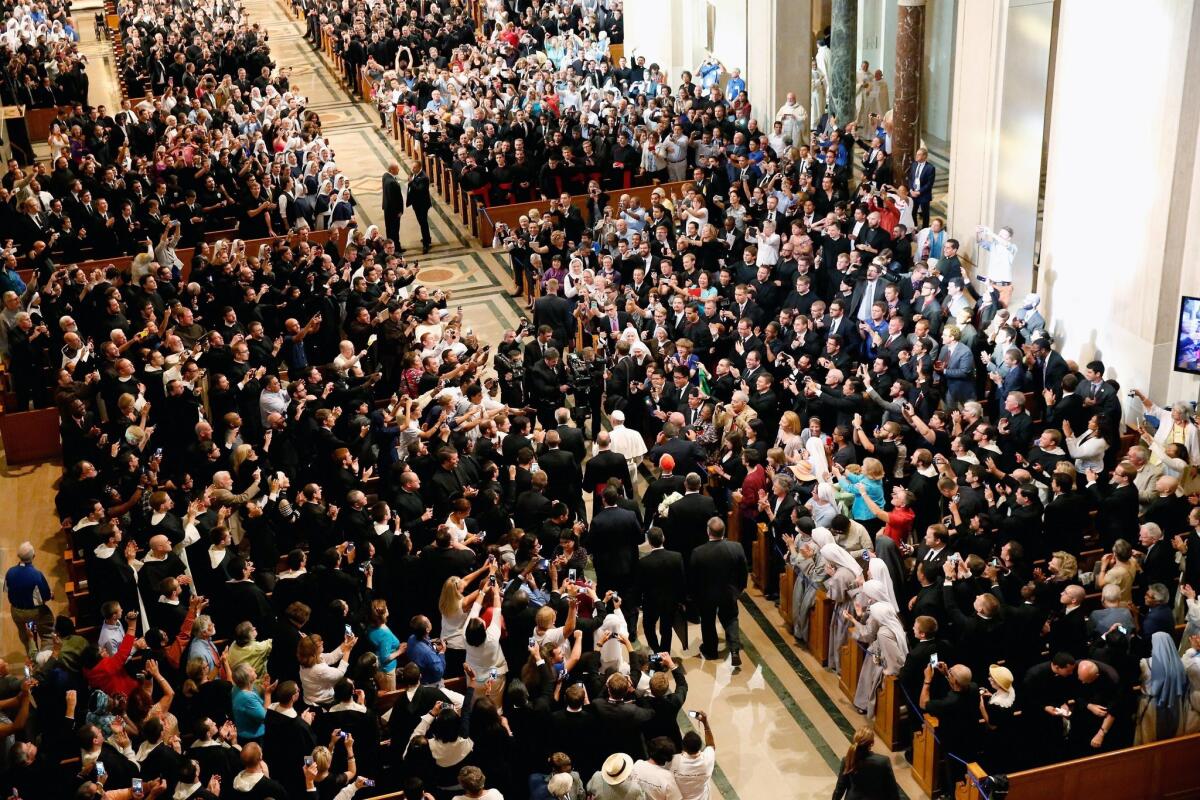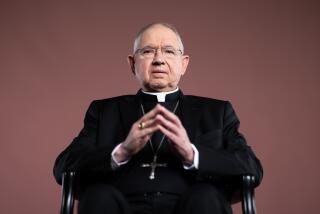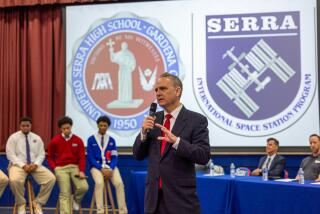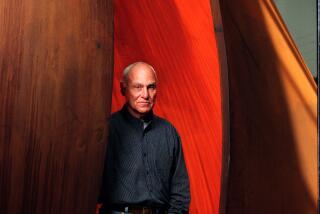Pope Francis canonizes Father Junipero Serra, saying he defended Native Americans

Pope Francis arrives for the canonization Mass for Junipero Serra at the Basilica of the National Shrine of the Immaculate Conception in Washington.
Reporting from Washington — Pope Francis called Father Junipero Serra a defender of “the dignity of the native community,” as the first pope from the Americas canonized the 18th century missionary known as the Apostle of California on Wednesday while celebrating his first Mass in the United States.
The ceremony to name a new Catholic saint, the first to take place on U.S. soil, came nearly 250 years after the Spanish Franciscan friar redefined the culture and history of the far West.
Serra evangelized indigenous people – sometimes with harsh methods - and established the church mission system that defined the Spanish colonial era in California.
In a sermon to 25,000 people crowded outside the ornate Basilica of the National Shrine of the Immaculate Conception, the largest Catholic church in the country, Francis addressed the missionary’s controversial legacy by portraying him as a protector, not an oppressor, of early Californians.
Serra “sought to defend the dignity of the native community, to protect it from those who had mistreated and abused it,” the Argentine-born pope said, speaking in Spanish from an altar outside the basilica. “Mistreatment and wrongs that today still trouble us, especially because of the hurt they cause in the lives of many people,” he said.
Serra’s critics did not organize any protests at the canonization ceremony. Some opponents said there was no use in trying to sway the church or the immensely popular pope at this point.
Before Francis spoke, the crowd roared as the glass-topped “popemobile” weaved among them on large paths. The 78-year-old pontiff took two laps along the main thoroughfare that separated the media from assigned seats, waving fitfully as the throng rose and cheered.
Many had waited hours in the open sun to see him, and medical teams rushed to help several who passed out. Large choirs performed liturgical and gospel music before the ceremony, shifting effortlessly from Aaron Copland to psalms.
For all its historical implications, the canonization Mass came hours after Francis made his first formal visit to the White House and challenged Americans of all faiths to address the modern problems of global warming, illegal immigration and the conflict over traditional families and cultural values.
“Climate change is a problem that can no longer be left to a future generation,” Francis told 11,000 people who gathered on the White House’s South Lawn for his welcoming ceremony. “When it comes to the care of our ‘common home,’ we are living at a critical moment of history.”
In a later meeting with U.S. bishops, Francis acknowledged “the pain of recent years” resulting from the church’s sexual abuse scandal, a poignant reminder during his six-day visit to Washington, New York and Philadelphia that many American Catholics have yet to forgive the church.
The nation’s capital, normally blase when world leaders visit, has been electrified by the arrival of Francis, who is making his first appearance in the United States. After dire warnings of the potential for historic traffic tie-ups, many downtown streets were eerily empty midmorning as people stayed home or took public transit to work.
One politician sought to nominate Francis for a Nobel Prize, and many tried to capture his glow. A bus driver sang gospel music while ferrying visitors to see the pope.
After the pontiff left the White House, people locked in dense crowds on the National Mall cried, snapped photos and bragged with certainty that he had locked eyes with them as he rolled along in his popemobile.
“He is our pope,” said Miriam Villatoro, a 40-year-old Guatemalan immigrant who cleans houses, as she stood for more than hour in line to watch Francis deliver Mass and canonize Serra. “He is the one we’re waiting for.”
Villatoro, who brought her two sons and her husband, was especially thrilled that Francis would speak in Spanish, the native language for her and millions of other Latinos who constitute the fastest-growing segment in the American Catholic Church.
“It’s like the voice of the immigrants,” she said.
Pope John Paul II beatified Serra in St. Peter’s Square in the Vatican on Sept. 25, 1988. Serra, he said at the time, “sowed the seeds of Christian faith amid the momentous changes wrought by the arrival of European settlers in the New World.”
In his homily Wednesday, Francis painted Serra as “the embodiment of ‘a church that goes forth.’”
“He was excited about blazing trails, going forth to meet many people, learning and valuing the particular customs and ways of life,” he said. “He learned how to bring to birth and nurture God’s life in the faces of everyone he met.”
Lesa Truxaw, director for worship for the Diocese of Orange, flew in from Costa Mesa. She wore a large crucifix made of gems and carried a card depicting Father Serra beside the mission he set up in San Juan Capistrano.
“We are No. 7,” she said proudly, alluding to the nine missions Serra founded in California after he arrived near San Diego in 1769. They were primarily designed to convert natives to the Catholic faith.
The church went on to establish 12 more from San Diego to San Francisco. Serra’s name can be found on streets, schools, parks, a freeway and statues up and down the state.
But to many Native Americans, Serra is a symbol of the mission system’s oppression.
Converted natives were kept separate from those who had not embraced Christianity, and some missions flogged and imprisoned those who tried to leave.
Critics say his legacy includes forced labor that supported the missions, which were crucial to Spain’s ambitions in the region. Spanish troops garrisoned near some missions were blamed for spreading syphilis and other diseases that devastated local communities.
Serra’s defenders say he must be viewed as flawed but depict him as a devout theologian who loved the people with whom he shared the gospel. They also point to efforts he made to protect natives from rape and other depredations by Spanish soldiers.
“He was a man of his times,” Truxaw said. “There is controversy. I don’t think we can whitewash that. I hope that, the indigenous, we can reach out to them and heal the hurt.”
Serra’s remains are buried under the sanctuary floor at the Mission San Carlos Borromeo in Carmel-by-the-Sea.
Twitter: @Noahbierman
Staff writer Marcus Howard contributed to this report.
MORE ON POPE’S U.S. VISIT:
Pope Francis’ sex abuse comments draw ire from victims
Four memorable moments on Pope Francis’ first day in Washington
Women as Roman Catholic priests? Opinions are divided -- and fiery
More to Read
Sign up for Essential California
The most important California stories and recommendations in your inbox every morning.
You may occasionally receive promotional content from the Los Angeles Times.











